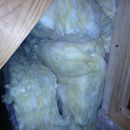Adding more insulation to an attic with R-38 fiberglass
I have a 2200 SF raised ranch built in 1983, with another 1000 SF finished in the portion of the basement with 4′ stem walls. The rest of the basement is unfinished. The heat is electric radiant throughout; on the main floor the heating cables are laid on top of the ceiling drywall. I’ve just moved in and the house was vacant for the previous two years, so I have no idea what to expect for heating bills.
The house is well built and insulated for its age, and the windows are mostly oriented to the south, so there is some heat gain in winter. There is R-38 fiberglass (two layers of R-19, with the bottom paper faced and in contact with the ceiling drywall; the top layer is unfaced) in the ceilings, insulated 2×6 exterior walls, and single-pane Pella casement windows with gasketed interior storm windows. The entire floor between the main floor and the basement is insulated to R-19. The house is not drafty at all, though there are many can lights. Replacing them with airtight cans and then getting a blower door test is my next step.
The house is in central Pennsylvania (5A climate zone.) Electric is about 9¢/kWh. Propane is available, but natural gas is not.
My question is this: I had an insulation contractor come in this week. He looked at the attic and said that to install blown-in cellulose insulation, all of the fiberglass would have to be removed, because if it wasn’t it would get compressed from the weight of the new cellulose. He also said that it would not be cost-effective to install more insulation of any sort, since the house already has R-38.
Is this really the case? Are there any other energy-conserving strategies I might consider? A geothermal heating system would be nice but it’s out of my reach at the moment.
Thanks!
Jonathan
GBA Detail Library
A collection of one thousand construction details organized by climate and house part










Replies
Jonathan,
First of all, cellulose contractors routinely install a layer of cellulose insulation on top of an existing layer of fiberglass batts. It's an excellent approach, because it reduces air leakage and convective loops through the batts. (That said, it's always best to lift the existing batts to perform air sealing work before adding more insulation.)
Your contractor may be right that adding more insulation on top of R-38 insulation won't be cost-effective. However, just because it isn't cost-effective, doesn't mean that you shouldn't do it.
Calculating cost effectiveness is difficult in this case, because it's hard to determine whether the fiberglass batts are really performing at R-38. Most batt installations are sloppy, so it's reasonable to assume that your attic insulation is not really performing at R-38.
Thanks, Martin. The installation looks above average, but it's definitely not perfect. I will seek another bid for cellulose.
It matters not at all that the R19s get compressed by the weight of the cellulose. When low density fiberglass is compressed, it's R value PER INCH goes up, even if the now-thinner layer doesn't perform at the labeled R value since it's not at full loft. (According to the manufacturers own published data, R19 batts perform at only R18 when compressed in to a 5.5" nominal 2x6 cavity, since they're tested and labeled at the full 6-1/4" loft- go figure!)
Low density fiberglass has significant loss of performance in cold-side-up applications unless it has a top-side air barrier. When blowing over fiberglass with cellulose that performance is restored, as long as there is at least 3" of cellulose, which is an order of magnitude more air-retardent than low density fiberglass like R19s.
Geothermal may be out of reach on a cost basis, but in a PA Zone 5 climate ductless mini-spits heat pumps with an HSPF of 11 or greater will deliver around 10,000 BTU per kwh averaged over the season (compared to your resistance heaters at 3412 BTU/kwh), taking about 2/3 off the power used for heating. Like wood-stoves etc it's point-source heating- only serving the area that has good convective proximity to the ductless head. Even a low end HSPF 8 mini-split would use less than half the power that your radiant is using. Any room/zone with a heat load of more than 5000BTU/hr at the 99% outside design temp can have it's own ductless head and run efficiently. In electrically heated houses with a lot of doored-off areas a single mini-split heat that can serve the largest zone will usually cut the heating bill in half. A name brand 1 ton mini-split runs less than $4K installed in my neighborhood, and can deliver ~15000 BTU/hr @ +5F, a bit more at +35F. Even if you're using it as a part solution the savings are significant.
At 9 cents/kwh the cost of heating with ductless techology will be LESS than heating with gas.
But specifying any heating system starts with a room-by-room heat load calculation using realistic indoor temps, and the 99% outdoor design temperature: http://www.energystar.gov/ia/partners/bldrs_lenders_raters/downloads/Outdoor_Design_Conditions_508.pdf